Henri Zipcy (1873-1950) by Michèle Alfonsi translated to English by Catherine Saiko, 2011
Henri Zipcy was born and raised up in Constantinople and went to Paris to complete his studies of architecture in the 1890ies at the renowned “École des Beaux-Arts” in the art-class of Gaston Redon, the brother of the famous French symbolist painter Odilon Redon. Henri was the cousin of my Smyrna-born great-grandmother Amélie and my mother still remembers well attending Sunday-afternoon parties with delicious homemade cakes and pastries at his home in Paris before WW2.
There are only few documents about Henri in the family-archives but there is his best-known project still standing at the Carrefour Barbès, Paris - view on map.
in Paris, currently under renovation by the municipality of Paris: the impressive building of the cinema-palace “Le Louxor”, built in 1921 with a striking Egyptian decor.
Since the extensive renovation project started a year ago we notice a steadily growing interest in Henri Zipcy and so I’m very grateful to Michèle Alfonsi, a member of the local association “Les Amis du Louxor” (The Friends of the Louxor), who recently published a well-researched article about our architect and who allowed me to translate it hereunder for the Anglophone readership:
Who are you, Mr. Zipcy?
by Michèle Alfonsi - French version:
The Architect of the Louxor
The Louxor was considered at its opening in 1921 as one of the most modern and comfortable cinema halls of Paris. Even today its architecture continues to fascinate passers-by and the restored brilliant facade will soon be illuminating again at the crossroads of Barbès. Its builder, however, has remained in the dark. The mysterious Mr. Zipcy - whose name has often been misspelled as Mr. Zipey or Ripey - has discreetly passed through the history of architecture. Only a few traces of him can be found in the archives that normally inform us about those whose works have enriched the architectural heritage.
Did this architect realize a masterstroke with the cinema-palace and afterwards he chose to retire to an architectural practice much less exposed to the limelight? Even the building that is today the subject of our attention takes up little space in the specialized literature, and his other works are quite unknown.
Henri Joseph Marie Zipcy was born on the 10th of December 1873 in Constantinople (Istanbul) into an Armenian Catholic family originating from Smyrna (Izmir). His father, André, was an owner and chief-editor of newspapers and published e.g. “La Turquie” and “L’Orient” in French. The family archives contain correspondence between him and Pierre Loti. He belonged to the respectable society of Pera, a district of Istanbul where Levantines lived in harmony next door to Armenians. Mansions, elegant homes and palaces of the bourgeoisie and the aristocracy were aligned next to the various embassies, life was pleasant, parties were celebrated, and the families spoke several languages fluently. So it is natural that Henri Zipcy went to France for his studies. In 1889 he arrived in Paris and in 1892 he was a student at the Beaux-Arts of Gaston Redon, the brother of the famous painter.
Little is known about his professional activities after he finished his studies in 1897. Did he start working in Paris, where several addresses are known of him at that time? Or did he work in Constantinople, where he married in 1912 a Catholic Italo-German Levantine, Frieda Leonhardi (the daughter of an engineer at the Ottoman Tobacco Régie)? The couple soon moved to Paris and from 1914 lived at the Boulevard Garibaldi No. 33 which became their home as well as the workshop of the architect.
The couple obtained the French citizenship in 1928 and gave their three sons a French education. The children studied at the Collège Stanislas and knew little about their origins, like many Armenians who had to leave Turkey at that time: maybe the parents preferred to protect their children by hiding a part of family history and the tragic events. One of the sons of Mr. Zipcy, Fernand, later became an architect in Cherbourg, where he died in June 2009.
A discrete architect
Similar to his discretion about his family history, Henri Zipcy was also discrete to his children about his career. Her granddaughter describes a sensitive and reserved man who considered himself more as an “artisan”, and whose descendants know little about his work. It seems a little difficult to imagine such an approach to architectural practice in our age of “starchitects”. Henri Zipcy worked for half a century essentially for private clients, designing individual homes and buildings for commercial use. He had shown with the spectacular example of Louxor that he was capable of innovation while still inputting his artistic know-how. Some questions, however, remain open such as what made him choose an Art Deco and Egyptian design for this cinema. Was that his choice? Or was the idea that of his client? Did his cosmopolitan education and his open mindedness towards other cultures affect this choice?
We know that after this work he was involved in architectural projects of commercial or individual use. Thus, on an old picture we see a millstone house built by him at Andrésy in the 1920’s for his personal use (he built another one in the same street for a friend).
He had chosen this quiet place in midst of the fields, after having thought about buying the “Boisserie” at Colombey-les-Deux-Eglises. A decade later the abandonment of this project enabled General de Gaulle to acquire it and make it his refuge. Henri Zipcy died in this house in Andrésy in 1950.
Some traces lead us to other projects of Henri Zipcy, but they did not achieve the brilliance of the Louxor... most of his buildings have been destroyed or transformed, they can only tell us a part of his story.
For a list of projects of Henri Zipcy for which building permits were applied for (in Paris) please refer directly to the original article in French
For more information on the Paris-Louxor Association:
Henri Zipcy was born and raised up in Constantinople and went to Paris to complete his studies of architecture in the 1890ies at the renowned “École des Beaux-Arts” in the art-class of Gaston Redon, the brother of the famous French symbolist painter Odilon Redon. Henri was the cousin of my Smyrna-born great-grandmother Amélie and my mother still remembers well attending Sunday-afternoon parties with delicious homemade cakes and pastries at his home in Paris before WW2.
There are only few documents about Henri in the family-archives but there is his best-known project still standing at the Carrefour Barbès, Paris - view on map.
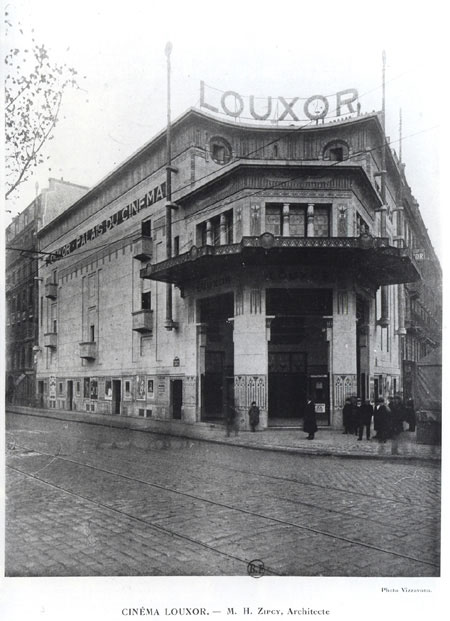 |
The movie theatre as it was in 1922 (source: Revue “La construction moderne”, 1922), below the 2013 projected view on completion
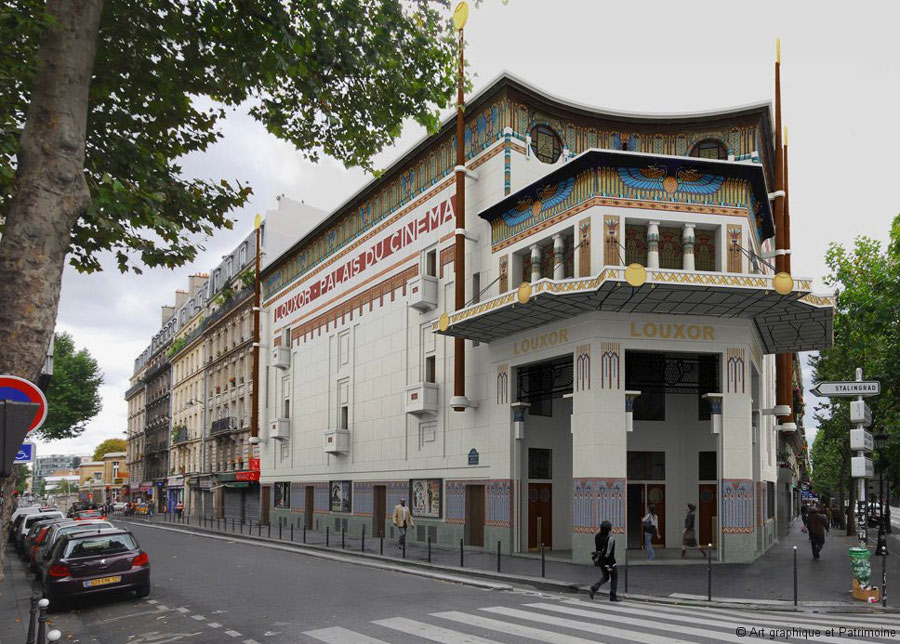 |
Click here to view more images of this building
in Paris, currently under renovation by the municipality of Paris: the impressive building of the cinema-palace “Le Louxor”, built in 1921 with a striking Egyptian decor.
Since the extensive renovation project started a year ago we notice a steadily growing interest in Henri Zipcy and so I’m very grateful to Michèle Alfonsi, a member of the local association “Les Amis du Louxor” (The Friends of the Louxor), who recently published a well-researched article about our architect and who allowed me to translate it hereunder for the Anglophone readership:
Who are you, Mr. Zipcy?
by Michèle Alfonsi - French version:
The Architect of the Louxor
The Louxor was considered at its opening in 1921 as one of the most modern and comfortable cinema halls of Paris. Even today its architecture continues to fascinate passers-by and the restored brilliant facade will soon be illuminating again at the crossroads of Barbès. Its builder, however, has remained in the dark. The mysterious Mr. Zipcy - whose name has often been misspelled as Mr. Zipey or Ripey - has discreetly passed through the history of architecture. Only a few traces of him can be found in the archives that normally inform us about those whose works have enriched the architectural heritage.
Did this architect realize a masterstroke with the cinema-palace and afterwards he chose to retire to an architectural practice much less exposed to the limelight? Even the building that is today the subject of our attention takes up little space in the specialized literature, and his other works are quite unknown.
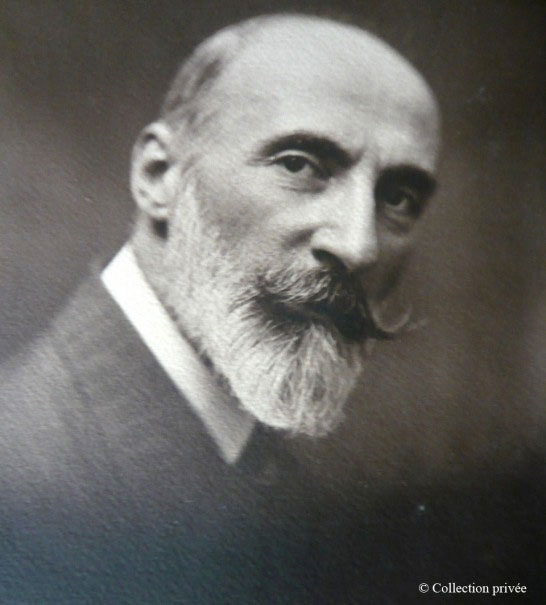 |
Henri Zipcy
Henri Joseph Marie Zipcy was born on the 10th of December 1873 in Constantinople (Istanbul) into an Armenian Catholic family originating from Smyrna (Izmir). His father, André, was an owner and chief-editor of newspapers and published e.g. “La Turquie” and “L’Orient” in French. The family archives contain correspondence between him and Pierre Loti. He belonged to the respectable society of Pera, a district of Istanbul where Levantines lived in harmony next door to Armenians. Mansions, elegant homes and palaces of the bourgeoisie and the aristocracy were aligned next to the various embassies, life was pleasant, parties were celebrated, and the families spoke several languages fluently. So it is natural that Henri Zipcy went to France for his studies. In 1889 he arrived in Paris and in 1892 he was a student at the Beaux-Arts of Gaston Redon, the brother of the famous painter.
Little is known about his professional activities after he finished his studies in 1897. Did he start working in Paris, where several addresses are known of him at that time? Or did he work in Constantinople, where he married in 1912 a Catholic Italo-German Levantine, Frieda Leonhardi (the daughter of an engineer at the Ottoman Tobacco Régie)? The couple soon moved to Paris and from 1914 lived at the Boulevard Garibaldi No. 33 which became their home as well as the workshop of the architect.
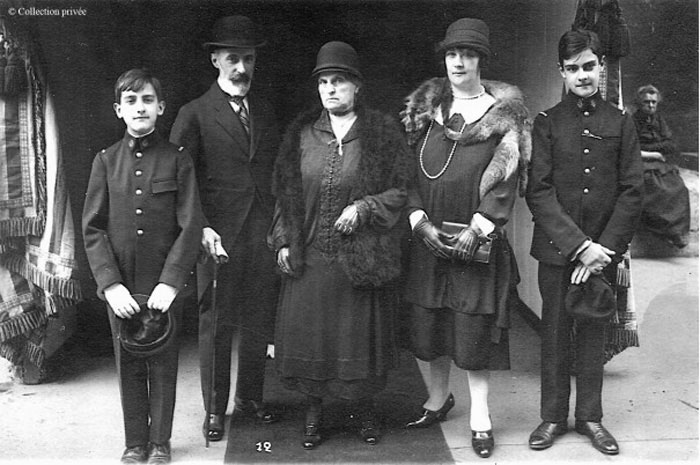 |
Henri Zipcy, his mother-in-law, his wife and his sons (wearing the school-uniform of the Collège Stanislas) at a family event in 1926.
The couple obtained the French citizenship in 1928 and gave their three sons a French education. The children studied at the Collège Stanislas and knew little about their origins, like many Armenians who had to leave Turkey at that time: maybe the parents preferred to protect their children by hiding a part of family history and the tragic events. One of the sons of Mr. Zipcy, Fernand, later became an architect in Cherbourg, where he died in June 2009.
A discrete architect
Similar to his discretion about his family history, Henri Zipcy was also discrete to his children about his career. Her granddaughter describes a sensitive and reserved man who considered himself more as an “artisan”, and whose descendants know little about his work. It seems a little difficult to imagine such an approach to architectural practice in our age of “starchitects”. Henri Zipcy worked for half a century essentially for private clients, designing individual homes and buildings for commercial use. He had shown with the spectacular example of Louxor that he was capable of innovation while still inputting his artistic know-how. Some questions, however, remain open such as what made him choose an Art Deco and Egyptian design for this cinema. Was that his choice? Or was the idea that of his client? Did his cosmopolitan education and his open mindedness towards other cultures affect this choice?
We know that after this work he was involved in architectural projects of commercial or individual use. Thus, on an old picture we see a millstone house built by him at Andrésy in the 1920’s for his personal use (he built another one in the same street for a friend).
He had chosen this quiet place in midst of the fields, after having thought about buying the “Boisserie” at Colombey-les-Deux-Eglises. A decade later the abandonment of this project enabled General de Gaulle to acquire it and make it his refuge. Henri Zipcy died in this house in Andrésy in 1950.
Some traces lead us to other projects of Henri Zipcy, but they did not achieve the brilliance of the Louxor... most of his buildings have been destroyed or transformed, they can only tell us a part of his story.
For a list of projects of Henri Zipcy for which building permits were applied for (in Paris) please refer directly to the original article in French
For more information on the Paris-Louxor Association:
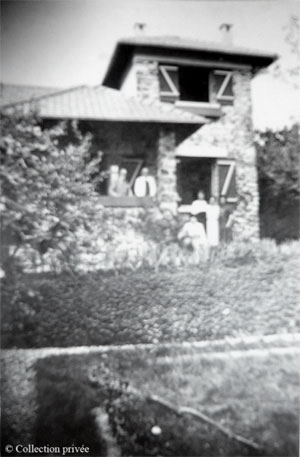 |
Henri Zipcy house at Andrésy